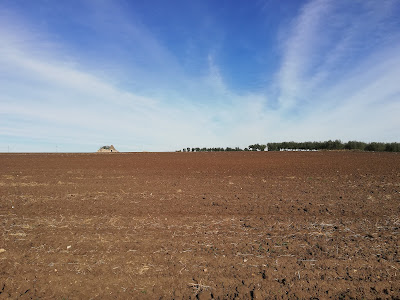Another fantastic day on the Cammino Materano!
Today's stage was a little shorter, and flatter, than the previous ones. We left Altamura on the industrial side of the town, past the flour mills that produce the key ingredient for the town's best-known specialty: its bread. Then we walked along dirt roads through vast expanses of fields, stopping just under halfway at Casalia for a snack of fruit and focaccia at Peppino's rest stop among the fields of melons, tomatoes and carderelli. Renovation work was underway on a wing of the house where Peppino is preparing some new rooms in which to host walkers.
 |
The human presence was never far away as we crossed this agricultural landscape, with the city of Altamura always visible on the horizon, until we reached a small wood only an hour's walk out of Gravina. A steep downhill stretch took us to the stone quarries on the outskirts of the town.
Gravina is built of, in, on, and under the calcareous rock of the Murgia, on the edge of a deep ravine (gravina, in Italian), spanned by an acqueduct bridge. Cypress trees grow in the bottom of the ravine, and caves have been hollowed out in its sides, in which people lived, worked, and worshipped until the middle of the last century.
 |
| View of the ravine from the bridge |
 |
| La Madonna della Stella Church |
To build the houses in the old town centre, people didn't even carry stone from the local quarry: they simply dug downward to obtain the stone with which to build upward, thus obtaining a cellar and a house at the same time. Leonardo, the referente di tappa and owner of the B&B where our friends were staying, showed us the cellars dug into the rock below his establishment.
Parts of the old town centre have been renovated, while other neighbourhoods still contain houses that are uninhabited and/or in need of restoration. Let's hope the necessary investment is forthcoming, and that this unique town gets the attention it deserves from international travellers, as well as walkers on the Cammino Materano!
We explored the maze of the old town centre before retiring for a rest at the aptly named La Tana della Volpe, ("the foxhole"), a small hostel (six beds) in one of these homes dug into the rock, at street level but with no windows other than the glass door. Our hostess, Rosa, explained that in times when people were happy to settle for less, her grandmother had lived here with her family of seven children!
 |
| Homemade pasta with cardarelli |





















No comments:
Post a Comment